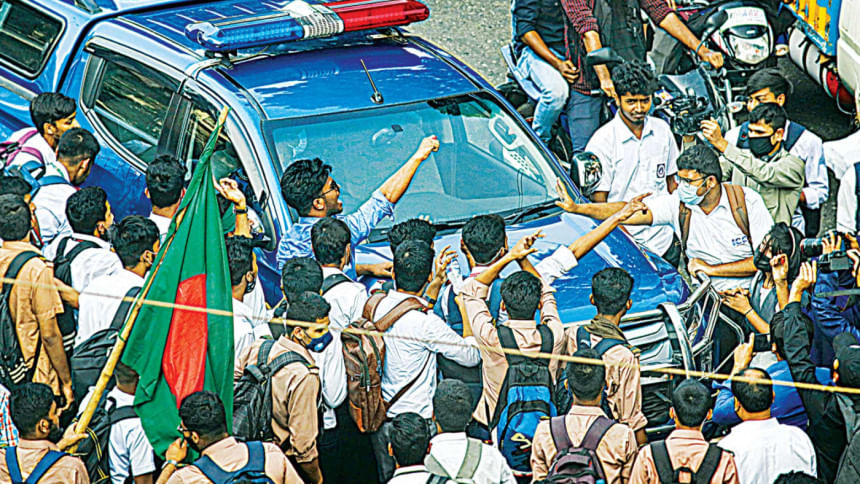Column by Mahfuz Anam: Our killer roads - Students have once again raised a vital issue

Just as we are making news as a role model of development, we are also attracting global attention as perhaps the only country in the world where school students need to demonstrate on the streets for days on end to demand road safety measures. Things that others take for granted—things that governments should take as a matter of law—are things school students in Bangladesh have to demonstrate on the streets for, occasionally facing attacks by criminal elements who profit from the lawlessness on our roads.
It has been around two weeks now that our school students have been demonstrating on the streets. For what? Except the demand for half fare on the buses for themselves, all the other demands have to do with road safety issues that concern all citizens of the country, not just students.
The number of deaths on the streets, especially of students, are just the tip of the iceberg of an all-encompassing malaise that has turned our roads into the deadliest in the world.
There are three main elements of the whole road safety question: The level of training of the drivers who run the buses, trucks and other vehicles—like the DNCC garbage truck being driven by the unlicensed assistant of its driver; the level of fitness of the vehicles and the quality of our roads, both in terms of planning and maintaining them; and finally, the state of our traffic system that is supposed to ensure safety for all who use them.
The situation of the drivers is clearly a recipe for disaster. To start with, there is no formal channel for their training. They learn to drive on the sly—from other drivers. Even if they get some rudimentary ideas about driving, they get absolutely no training on traffic laws, differences in driving on the city roads and the highways, when or when not to overtake, how to navigate turns, especially narrow ones, and about driving within one's lane.
A large number of drivers have no licence—one of the grievances expressed by the agitating students was the high number of drivers without any licence, including those found driving several police cars. Those who do mostly have fake ones. They are procured through bribery, without any test or any sort of screening.
Just imagine: drivers with some rudimentary exposure to driving and with no practical exposure to traffic rules, no idea of the differences between light vehicles, like private cars, and heavy ones, like buses and trucks, are allowed total freedom on our streets to drive any vehicles that their owners assign. Add to that the fact that most drivers never face any medical examination—many drivers have never had an eye examination—or psychological counselling on how to manage pressure and tension on the road. Add further to the above fact that many drive for hours, sometimes all through the night, without adequate rest. It's quite possible that many drivers may need glasses, which they don't know about, and some may even suffer from occasional night blindness.
If you put all of the above together, is it any wonder that our roads are as dangerous as we are now seeing them to be?
Then comes the issue of how scientifically our roads are constructed, and how regularly they are maintained to ensure safety. We have reported several instances where accidents were caused solely due to badly planned roads, non-existent stop signs, confusing intersections, no indication for blind turns, and insufficient signals for oncoming traffic.
Often, roads are not maintained, which poses a serious threat to vehicles and to the passengers. On occasions that a section of a road is closed for maintenance, the diversion is so inadequately spaced and marked that those accidents become inevitable. It is not known how much the unscientifically placed speed breakers have helped to ensure safety, but they definitely have contributed to the rising back problems of the passengers.
Is there anything called a traffic system prevalent here? Well, if Dhaka city traffic is anything to go by, then there isn't. If there is a practical illustration of the phrase "anything goes," then our streets exemplify it. Anything that moves is on our streets—from the fast moving to the very slow, from the fully mechanical to the completely human-powered, from very small, compact ones to the highly oversized ones. There are no clear directives as to the type of vehicles allowed on the streets and ones which are not, with the result that our traffic is among the slowest in the world. The World Bank reported some years back that in the very near future, the speed of motorised vehicles on our streets would be the same as that of pedestrians.
There is practically nothing called parking restrictions on our highly over-subscribed streets. Literally, anyone can park anywhere—sometimes blocking a whole lane. If you are linked with the powers that be, then of course you can park at the busiest corner with impunity. The "no parking" signs are more observed in their violation and act as sources of extra money for allowing illegal parking.
Perhaps, the matter of most concern is the manner in which those who violate traffic rules are treated, even when those violations lead to fatality. An example of the clout of the bus owners and concerned unions is that they were able to force modification and outright elimination of some important passenger rights protection provisions before the adoption of the Road Transport Act, 2018 in parliament. Even after adoption, operation of some approved provisions has been held back.
Taking everything into consideration—the indiscipline, the corruption, the lack of ability to enforce the law, the lack of training, and the lack of supervision—the road transport sector remains as one of the most neglected sectors, where passenger rights are practically non-existent. From providing unsafe vehicles, to hiring untrained drivers, with no road discipline to speak of, no law enforcement that is of any consequence, and no accountability on the part of the drivers and owners if an accident occurs, including those that cause loss of lives—our roads have been and continues to be "killing fields" in every sense, except the name.
So, the issues that the students have raised is a national one, a matter of concern for everyone in the country far beyond the needs of the students themselves. The nation should express gratitude to them for raising the issue that always seems to get ignored under the pressure of the bus and truck lobbies.
The prime minister's call for the students to go back to their classes and not to indulge in vandalism is a correct one. But what happens when the students do heed her words? They listened in 2018. Did anything change, especially the daily killings that occur on our roads? The issue is not about punishing a few who were responsible for some recent deaths. It is a far wider one that concerns the totality of our road transport system, the system of running private buses within the city and beyond, the way trucks are hired, loaded with goods weighing far more than they are legally allowed to. We must examine the question of total indiscipline on the city streets and highways, the corruption in issuing fake licences, the ways in which vehicle maintenance tests are carried out—mostly manually, without proper equipment and checks—and the overall lawlessness in which this sector functions.
Our students' actions must trigger a wider and deeper examination of the issue of safe roads, which affects all of us.
Mahfuz Anam is the editor and publisher of The Daily Star.

 For all latest news, follow The Daily Star's Google News channel.
For all latest news, follow The Daily Star's Google News channel. 



Comments